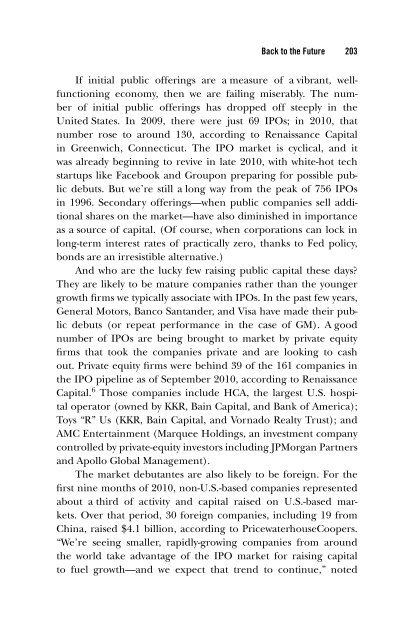3c hapter - Index of
3c hapter - Index of
3c hapter - Index of
Create successful ePaper yourself
Turn your PDF publications into a flip-book with our unique Google optimized e-Paper software.
Back to the Future 203<br />
If initial public <strong>of</strong>ferings are a measure <strong>of</strong> a vibrant, wellfunctioning<br />
economy, then we are failing miserably. The number<br />
<strong>of</strong> initial public <strong>of</strong>ferings has dropped <strong>of</strong>f steeply in the<br />
United States. In 2009, there were just 69 IPOs; in 2010, that<br />
number rose to around 130, according to Renaissance Capital<br />
in Greenwich, Connecticut. The IPO market is cyclical, and it<br />
was already beginning to revive in late 2010, with white- hot tech<br />
startups like Facebook and Groupon preparing for possible public<br />
debuts. But we’re still a long way from the peak <strong>of</strong> 756 IPOs<br />
in 1996. Secondary <strong>of</strong>ferings—when public companies sell additional<br />
shares on the market—have also diminished in importance<br />
as a source <strong>of</strong> capital. (Of course, when corporations can lock in<br />
long- term interest rates <strong>of</strong> practically zero, thanks to Fed policy,<br />
bonds are an irresistible alternative.)<br />
And who are the lucky few raising public capital these days?<br />
They are likely to be mature companies rather than the younger<br />
growth fi rms we typically associate with IPOs. In the past few years,<br />
General Motors, Banco Santander, and Visa have made their public<br />
debuts (or repeat performance in the case <strong>of</strong> GM). A good<br />
number <strong>of</strong> IPOs are being brought to market by private equity<br />
fi rms that took the companies private and are looking to cash<br />
out. Private equity fi rms were behind 39 <strong>of</strong> the 161 companies in<br />
the IPO pipeline as <strong>of</strong> September 2010, according to Renaissance<br />
Capital. 6 Those companies include HCA, the largest U.S. hospital<br />
operator (owned by KKR, Bain Capital, and Bank <strong>of</strong> America);<br />
Toys “R” Us (KKR, Bain Capital, and Vornado Realty Trust); and<br />
AMC Entertainment (Marquee Holdings, an investment company<br />
controlled by private- equity investors including JPMorgan Partners<br />
and Apollo Global Management).<br />
The market debutantes are also likely to be foreign. For the<br />
fi rst nine months <strong>of</strong> 2010, non- U.S.-based companies represented<br />
about a third <strong>of</strong> activity and capital raised on U.S.-based markets.<br />
Over that period, 30 foreign companies, including 19 from<br />
China, raised $4.1 billion, according to PricewaterhouseCoopers.<br />
“We’re seeing smaller, rapidly- growing companies from around<br />
the world take advantage <strong>of</strong> the IPO market for raising capital<br />
to fuel growth—and we expect that trend to continue,” noted
















